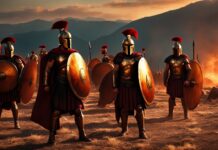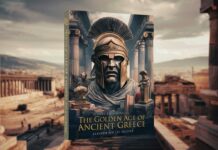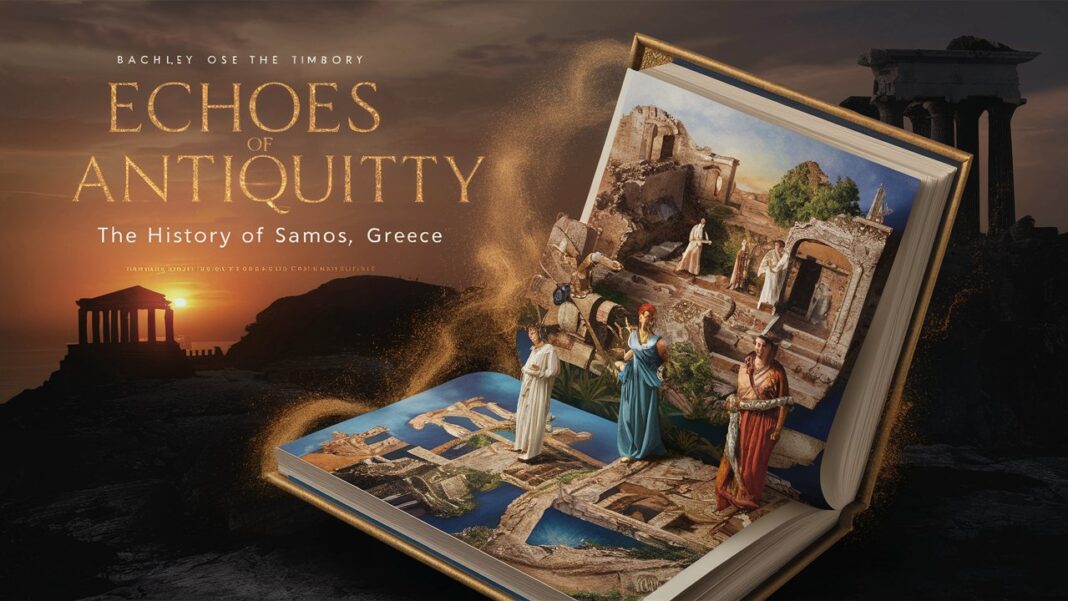Echoes of Antiquity: The History of Samos, Greece
Table of Contents
- Introduction
- The Dawn of Samos
- The Golden Age of Samos
- The Influence of Pythagoras
- Samos Under Persian Rule
- The Hellenistic Period
- Roman and Byzantine Samos
- Medieval Samos
- The Ottoman Era
- Samos in the Modern Age
- Conclusion
- Overview
Introduction
Samos, a gem in the Aegean Sea, holds a storied past that stretches back to antiquity. This island, renowned for its lush landscapes, vibrant culture, and strategic position, has played a pivotal role in the tapestry of Greek history. From its mythical origins to its influence on philosophy, mathematics, and politics, Samos offers a fascinating journey through time.
This e-book aims to provide an in-depth exploration of Samos’s history, highlighting its significant periods and contributions. Whether you are a history enthusiast, a traveler seeking deeper insights, or a student of classical studies, this book will illuminate the rich legacy of Samos.
Chapter 1: The Dawn of Samos
The earliest traces of human habitation on Samos date back to the Neolithic period. Archaeological findings suggest that the island was inhabited as early as the 3rd millennium BCE. The strategic location of Samos made it an essential hub for trade and cultural exchange in the Aegean.
The first settlers of Samos were likely influenced by the Minoan and Mycenaean civilizations. Evidence of Minoan pottery and Mycenaean artifacts indicates a close connection with these advanced cultures. By the time the Ionians arrived, around the 11th century BCE, Samos was already a thriving community.
The island’s natural resources, including its fertile soil and abundant water supply, contributed to its early prosperity. Samos became known for its agricultural products, particularly wine and olives, which were highly prized in the ancient world.
Chapter 2: The Golden Age of Samos
The 6th century BCE marked the Golden Age of Samos. Under the tyrant Polycrates, the island reached unprecedented levels of wealth and power. Polycrates’ reign is often considered a high point in Samian history, characterized by military expansion, architectural innovation, and cultural flourishing.
Polycrates established a powerful navy, which dominated the Aegean Sea and secured trade routes. His ambitious building projects, such as the Heraion (a grand temple dedicated to the goddess Hera) and the Eupalinian aqueduct (an engineering marvel of its time), showcased the island’s prosperity and advanced capabilities.
During this period, Samos became a center for the arts and sciences. The island attracted poets, musicians, and scholars, contributing to a vibrant cultural scene. The economic and cultural achievements of Samos during its Golden Age left an indelible mark on Greek history.
Chapter 3: The Influence of Pythagoras
One of the most illustrious figures associated with Samos is Pythagoras, the renowned philosopher and mathematician. Born on the island around 570 BCE, Pythagoras founded a school of thought that profoundly influenced Western philosophy and science.
Pythagoras is best known for his contributions to mathematics, particularly the Pythagorean theorem. However, his influence extended beyond mathematics to include music, astronomy, and ethics. The Pythagorean school, with its emphasis on harmony and numerical relationships, laid the groundwork for future scientific and philosophical inquiries.
The legacy of Pythagoras is a testament to the intellectual environment of Samos. His teachings and discoveries continue to resonate through the ages, highlighting the island’s role as a cradle of knowledge and innovation.
Chapter 4: Samos Under Persian Rule
In the late 6th century BCE, Samos, along with much of the Greek world, came under the control of the Persian Empire. The island’s strategic importance and naval strength made it a valuable asset for the Persians.
Despite the external control, Samos managed to retain a degree of autonomy. The islanders navigated a complex political landscape, balancing their allegiance to Persia with their desire for independence. This period saw Samos involved in the larger geopolitical struggles of the time, including the Ionian Revolt and the Greco-Persian Wars.
The experience of Persian rule had lasting effects on Samos, influencing its political structures and external relations. The island’s resilience and adaptability during this tumultuous era are notable aspects of its history.
Chapter 5: The Hellenistic Period
Following the conquests of Alexander the Great, Samos became part of the Hellenistic world. The island experienced significant changes as it integrated into the vast territories ruled by Alexander’s successors, the Diadochi.
The Hellenistic period was marked by increased cultural exchange and the blending of Greek and Eastern influences. Samos benefited from these interactions, becoming a cosmopolitan center that attracted merchants, scholars, and artists from across the Mediterranean.
During this time, Samos continued to develop its economic and cultural foundations. The island’s strategic location and natural resources ensured its prosperity, while its intellectual and artistic contributions added to the richness of Hellenistic civilization.
Chapter 6: Roman and Byzantine Samos
Samos’s incorporation into the Roman Empire brought stability and integration into a larger economic and political system. The island thrived under Roman rule, benefiting from the Pax Romana and the extensive trade networks of the empire.
The Romans valued Samos for its strategic position and resources. The island became an important stopover for trade routes and a center for agricultural production. Roman architecture and infrastructure projects further enhanced the island’s development.
With the division of the Roman Empire, Samos became part of the Byzantine Empire. The Byzantine period saw the island navigating the challenges of invasions, religious transformations, and administrative changes. Despite these upheavals, Samos maintained its significance in the Aegean region.
Chapter 7: Medieval Samos
The medieval history of Samos is characterized by a series of conquests and changes in dominion. The island faced invasions from various powers, including the Arabs, Venetians, and Genoese, each leaving their mark on its cultural and political landscape.
During this period, Samos experienced periods of decline and resurgence. The island’s economy fluctuated, influenced by external conflicts and internal developments. Nevertheless, Samos remained a vital link in the network of Aegean trade and communication.
The medieval era also saw the emergence of new architectural and artistic styles, reflecting the diverse influences that shaped the island. Churches, fortifications, and other structures from this time period provide a glimpse into the evolving history of Samos.
Chapter 8: The Ottoman Era
In the 15th century, Samos fell under Ottoman rule. The island’s strategic importance continued to make it a valuable possession, and the Ottomans integrated Samos into their vast empire.
Under Ottoman administration, Samos experienced relative stability and economic growth. The island’s agricultural products, particularly wine and olives, remained significant exports. The Ottomans implemented administrative and social reforms that affected the daily lives of the islanders.
Despite the challenges of foreign rule, Samos retained a strong sense of cultural identity. The local population adapted to the new political realities while preserving their traditions and customs. This period of Samos’s history is marked by a blend of continuity and change.
Chapter 9: Samos in the Modern Age
The modern history of Samos is characterized by its struggles for independence and integration into the modern Greek state. The 19th and early 20th centuries were a time of significant upheaval and transformation for the island.
Samos played a role in the Greek War of Independence, contributing to the broader struggle against Ottoman rule. The island’s strategic location and spirited populace made it a key player in the conflict. Following the war, Samos enjoyed a brief period of autonomy before becoming part of the modern Greek nation.
In the 20th century, Samos faced new challenges, including the impacts of world wars and economic changes. The island continued to evolve, balancing its rich historical legacy with the demands of contemporary life.
Chapter 10: Conclusion
The history of Samos is a tapestry woven with threads of myth, conquest, culture, and resilience. From its earliest days as a hub of trade and civilization to its modern identity as part of Greece, Samos has played a significant role in the broader narrative of the Aegean and Mediterranean regions.
The island’s contributions to philosophy, science, and the arts, particularly through figures like Pythagoras, underscore its enduring legacy. The strategic importance of Samos has made it a focal point in various historical epochs, each leaving a distinct imprint on its character.
Today, Samos continues to captivate visitors with its natural beauty and historical richness. The echoes of antiquity reverberate through its landscapes and monuments, inviting exploration and reflection.
Overview
Echoes of Antiquity: The History of Samos, Greece, provides a comprehensive look at the island’s remarkable past. From the dawn of civilization to the modern age, each chapter delves into the key periods and events that shaped Samos. This e-book offers readers a journey through time, highlighting the island’s contributions to culture, science, and politics.
Samos’s story is one of resilience and adaptation, marked by its ability to thrive despite external challenges. The island’s rich heritage, from its mythical beginnings to its modern identity, is a testament to the enduring spirit of its people.




















